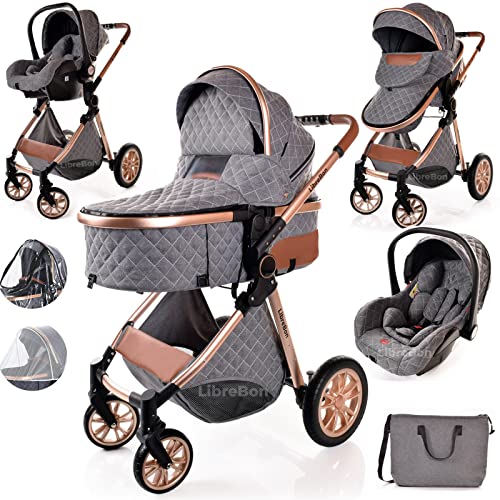Pram or Pushchair: A Comprehensive Guide for New Parents
Picking the right mode of transportation for children is one of the first considerable choices new moms and dads face. With various alternatives on the marketplace, the dispute in between prams and pushchairs can be bewildering. This short article will offer in-depth insights into the differences in between prams and pushchairs, their specifications, benefits and downsides, and what to think about before making a purchase.
Comprehending Prams and Pushchairs
At its core, the choice in between a pram and a pushchair lies in their style and intended usage.
Definitions:
- Pram: A pram, short for "perambulator," is developed mainly for newborns. It features a flat, carrycot-style seat that permits the baby to rest entirely flat. Prams are typically more glamorous and are planned for transferring babies who are not yet sitting up individually.
- Pushchair: A pushchair, likewise known as a stroller, is developed for older infants and toddlers who can stay up. Pushchairs usually have an upright seat and might not recline entirely flat, although many models now provide adjustable reclining choices for convenience.
Key Differences:
| Feature | Pram | Pushchair |
|---|---|---|
| Age of Use | Newborn to about 6 months | 6 months to 4 years or more |
| Seating Position | Flat, lying down | Upright or somewhat reclined |
| Weight | Normally much heavier | Generally lighter |
| Portability | Less portable due to weight | More portable and much easier to fold |
| Usage Case | Short strolls, leisurely strolls | Daily use, errands, longer getaways |
Advantages and Disadvantages
Pram
Advantages:
- Comfort for Newborns: Provides a flat surface conducive to a newborn's developmental needs.
- Stylish Designs: Many prams featured classy designs, offering a touch of luxury.
- Storage Space: Sometimes consist of larger storage alternatives below.
Drawbacks:
- Weight: Generally heavier and bulkier than pushchairs.
- Restricted Usage: Suitable only for newborns and infants who can not stay up.
Pushchair
Advantages:
- Versatility: Suitable for older babies and toddlers, frequently accommodating them for several years.
- Lightweight and Portable: Easier to fold and carry, making them ideal for hectic moms and dads.
- Configurable Options: Many pushchairs have adjustable seats and accessories for safety seat and carrycots.
Downsides:
- Comfort for Newborns: Not constantly suitable for babies in the early months without an appropriate insert.
- Less Luxurious: Often perceived as less elegant compared to prams.
Making the Right Choice
When it pertains to deciding between a pram and pushchair, numerous aspects should be considered:
1. Way of life:
- If moms and dads often make long trips or go for strolls, a pram may be preferential.
- If they require to navigate through city streets or take public transport, a lightweight pushchair might be preferable.
2. Budget:
Pricing can vary extensively. Understanding your financial limits will assist concentrate on alternatives that meet both visual and practical criteria.
3. Adaptability:
Some progressive services consist of travel systems that permit parents to transition from a safety seat to a pushchair with the very same base, providing maximum flexibility.
4. Storage Space:
A pram might use up more room in a vehicle or in the house, while a pushchair's ability to fold down can be a significant advantage in tighter areas.
Frequently asked questions
Q1: Can I utilize a pushchair for newborns?
A1: Some pushchairs feature bassinet attachments or totally reclining seats, making them suitable for newborns. However, it's important to inspect the specifications before use.
Q2: How do I select the best design?
A2: Consider your lifestyle, spending plan, and the functions you focus on, such as weight, mobility, and storage options.
Q3: Are prams and pushchairs safe for my baby?
A3: Yes, both prams and pushchairs are developed with security features. Try to find Full Survey with a 5-point harness, sturdy brakes, and secure frames.
Q4: How long can I use a pram for?
A4: A pram is typically appropriate till a baby can stay up unassisted, normally around 6 months.
Q5: What are travel systems?
A5: Travel systems are mixes of an automobile seat and a pushchair that operate in tandem, enabling simple shifts from cars and truck to pushchair without requiring to eliminate the baby.
Picking in between a pram and a pushchair eventually comes down to the needs and way of life choices of each household. Prams use comfort and design for babies, while pushchairs supply flexibility and ease for older babies and young children. By thoroughly considering individual scenarios and requirements, moms and dads can make an informed choice that will make sure safe and pleasurable trips with their youngsters.
In the end, whether one go with a stylish pram or a useful pushchair, the primary objective remains the exact same-- making sure comfort and safety for the kid while assisting in convenience for moms and dads.

